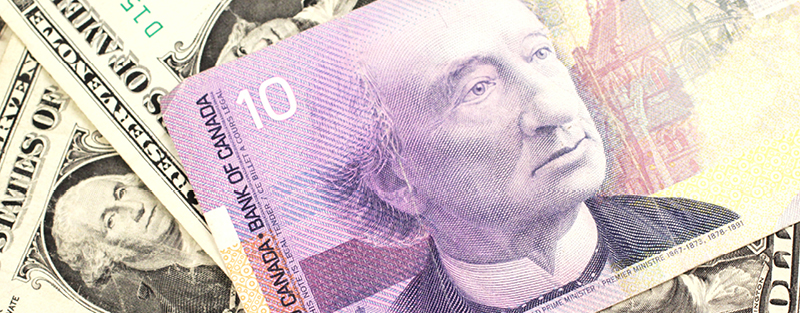Strategic Exchange
History of the Canadian Dollar
February 10, 2023 by Peter Muldowney

This summary provides a perspective of the modern-day history of Canadian-US dollar exchange rate fluctuations. Figure 1 shows the level of month-end exchange rates from 1953 to December 31, 2022.
Figure 1: History of Canadian-US Exchange Rates
| 1953-1960 | The Canadian dollar spent much of 1953 to 1960 in the $1.02 to $1.06 (US) range. It topped out at $1.0614 (US) on August 20, 1957. Until 2007 this was considered the modern-day peak for the Canadian dollar versus the US currency. The Canadian dollar was at $2.78 (US) in 1864 during the US Civil War, but in those days, it was pegged to the gold standard, a practice the US had already abandoned. |
|---|---|
| 1961-1969 | In the early 1960s, the Bank of Canada governor James Coyne and Prime Minister John Diefenbaker were on different economic paths. The government wanted expansion while Coyne wanted to maintain a tight money supply. Coyne subsequently resigned and in May 1962, the government pegged the Canadian dollar at 92.5 cents (US) plus or minus a 1% band. |
| 1970-1972 | In May 1970, with rising inflation and serious wage pressures, the Trudeau government allowed the Canadian dollar to float. It drifted to parity with the US dollar by 1972. |
| 1974 | On April 24, 1974, the Canadian dollar reached $1.0443 (US). This was the high point for the dollar from when it entered its most recent float period and would not trade at these levels again for another 30 years. |
| 1976- 1986 | In November 1976, René Lévesque became Premier of Quebec with a platform that promoted political independence for Quebec. A slide in the Canadian dollar resulted, lasting into the first half of the 1980s. This was a period characterized by rising inflation and interest rates. The Bank of Canada’s key interest rate reached 21.2% in 1981, and the Canadian dollar hit an all-time low of 69.13 cents (US) on February 4, 1986. |
| 1987- 1997 | The Canadian dollar rose through the latter part of the 1980s and early 1990s, and on November 4, 1991, reached 89.34 cents (US). This was the high point for the 1990s. |
| 1998-2002 | Budget deficits, weaker commodity prices and the aftermath of the international crisis in 1998 in the emerging markets of Russia and Latin America, saw a downward path for the Canadian dollar. On January 21, 2002, the Canadian dollar hit its all-time low against the US dollar dropping to 61.79 cents (US). At this level it cost $1.62 CDN to buy $1 US. |
| 2003- 2006 | Through 2003 to 2006, the Canadian dollar started to appreciate sharply driven by a robust global economy that boosted prices of Canada?s commodity exports and pushed the Canadian dollar above 90 cents (US). |
| 2007 | On September 20, 2007, the Canadian dollar reached parity with the US dollar for the first time in close to 31 years, with a 62% rise in less than six years driven in part by record high prices for oil and other commodities. The Canadian dollar was named the Canadian Newsmaker of the Year for 2007 by the Canadian edition of Time magazine. |
| 2008- 2009 | The Canadian dollar continued to trade near parity in the first half of 2008, but then started a decline that saw it drop below 80 cents (US). |
| 2010 | After a strong bounce back, the Canadian dollar reached parity for the first time in 20 months in April 2010. |
| 2011 | At the height of the commodity boom, the Canadian dollar reached $1.06 (US) on July 21, 2011. It then experienced its fastest decline in modern-day history as commodity prices rapidly deteriorated. |
| 2016 | The Canadian dollar fell to 68.68 cents (US) on January 19, 2016, approximately 7 cents (US) from its historic low, before starting to strengthen against the US dollar and finishing the year at 74.57 cents (US). |
| 2017- 2022 | Currency fluctuations have been somewhat muted since 2016, although the Canadian dollar dipped back down to around the 70 cents mark in March 2020 during the outset of the COVID pandemic. The Canadian dollar subsequently strengthened and ended 2022 at 73.80 cents (US). |
Figure 2 shows the history of exchange rates from 1970. It captures three modern-day major declines in the Canadian dollar versus the US dollar.
Figure 2: Canadian-US Exchange Rates
The three peak to trough declines in the Canadian dollar have all been down a little over 30%. The first two declines took around 10 years, while the most recent has been the fastest decline, which was in part due to the swift collapse in oil prices.
Since the last trough in 2016, the Canadian dollar continues to move in a relatively narrow range even accounting for the uncertainty associated with the COVID-19 pandemic and the current high levels of inflation. The Canadian dollar would have to fall below 68.68 cents (US) to test what was previously thought to be the low point for the most recent peak to trough.
Sources: Bank of Canada, CBC, Globe & Mail.



